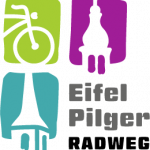Station:
Klausen

Abtsgarten
Klausen Pilgrimage church “Maria Heimsuchung”
For 500 years, people from near and far have sought help from the Sorrowful Mother of God in Klausen. After St. Matthias in Trier, Klausen is still the second largest place of pilgrimage in the Diocese of Trier.
The place can be traced back to day labourer Eberhard, who set up an image of the Sorrowful Mother of God here in 1440, before which he prayed daily. Inspired by visions of Mary, he built a devotional shrine, which was expanded into a small church by 1448/49. Word of the miraculous image spread quickly, so that many people from the region came to seek help. Eberhard built a hermitage or chapel (“Klause”) next to the church, after which the present village is named.

Alte Grabstein-Bildstöcke im Abtsgarten

Säulengang der Wallfahrtskirche Maria Heimsuchung
After his death in 1451, the church in Trier, with the support of the lords of Esch and presumably on the recommendation of the great cardinal of the Moselle, Nicholas of Cusa, decided to establish a reform monastery of the Augustinian canons regular of the Windesheim congregation at the place of pilgrimage. The first canons who settled here in 1456 came from the monasteries of Böddeken in Westphalia and Niederwerth near Koblenz. After the foundation of the monastery was completed around 1460, Klausen flourished in the following centuries. The impressive pilgrimage church (49° 54′ 18˝ N / 6° 53′ 00˝ E), which was completed in 1502, bears witness to this. It contains the chapel of grace with Eberhard’s image of Mary, a larger 17th-century miraculous image and a late Gothic high altar with a depiction of the Passion of Christ, which the canons acquired in Antwerp in 1480 and which is one of the oldest Brabant carved altars. Their heritage also includes the monastery’s library room, which is furnished with 16th-century wall paintings and unique in the Rhineland.
Economically, the canons were very successful, and by the 18th century, the monastery with its estates on the Middle Moselle was considered the fifth largest vineyard owner in the Electorate of Trier. The canons from Klausen were on good terms with the Cistercians in Himmerod, who ran an agricultural estate at Hof Haardt near Altrich. The Klausen convent was dissolved in 1802 in the course of the secularisation of the Electorate of Trier.

Pfarrheim mit Walmdach: Ehemalige klösterliche
To preserve the church and the place of pilgrimage, a new parish of Klausen was created with the villages of Pohlbach and Krames, which served as a model for the newly established local parish in 1969. As with all important places of pilgrimage, tales of miracles in Klausen have also been passed down. One of the oldest Marian miracles is the miracle of the “Eberhardsfässchen” (“Eberhard’s cask”), which was recorded in the Klausen monastery chronicle of Wilhelm von Bernkastel († 1536).
It reports that when the first church was being built, “Eberhard” had a cask of Moselle wine brought to invigorate the workers. When the wine ran out, the workers became dissatisfied. Trusting in the Mother of God, Eberhard went to his miraculous image and pleaded: “Oh Lady, I have done my part, now it is your turn. Help me in this time of need!” His plea was answered and the cask was once again full of the best wine. In memory of this miracle, the news of which spread like wildfire in the Eifel and Moselle region, a small cask was placed on the church tower.
Cycling with all the senses
On the search for contemplation, deceleration and the desire for peace and serenity, the Eifel Pilgrimage Cycle Route leads past numerous old churches, two uniquely characteristic monasteries and countless, lovingly restored and historically significant wayside crosses and shrines. Small anecdotes, passed down with a smile, about answers to prayers or authentic stories about human fates of past centuries, combined with an incredibly varied landscape, make for an all-encompassing cycling experience.

Antwerpener Passionsaltar von 1480
For more information visit www.Klausen.de
Miracles – learning to see and be amazed
When something happens that could not happen according to the rules of our world – Jesus turns water into wine, feeds 5,000 people with five loaves and two fish, heals the blind and the lame, resurrects the dead – we speak of miracles or miraculous signs. Jesus did not perform these miracles to aggrandise himself, but rather to show: God creates a new reality. God wants to heal our bodies and spirits. Do we have to believe this? Let’s put it like this: If we have a notion that our world is more than a sum of formulas and natural laws, we can see and be amazed …
Text: Online portal katholisch.de, Bonn
E-bike charging station
At this station you will find an e-bike charging station! It is located at Eberhardstraße 3, Klausen.
